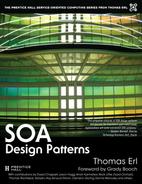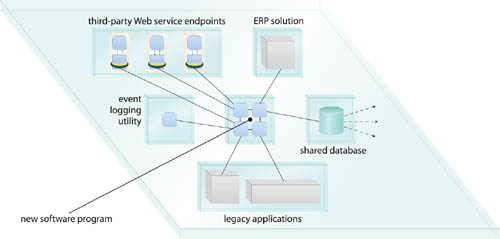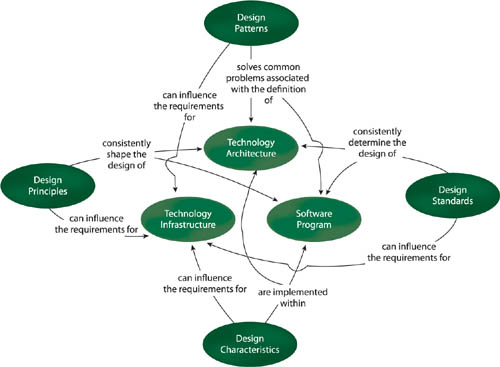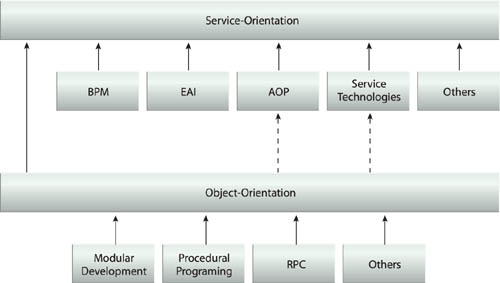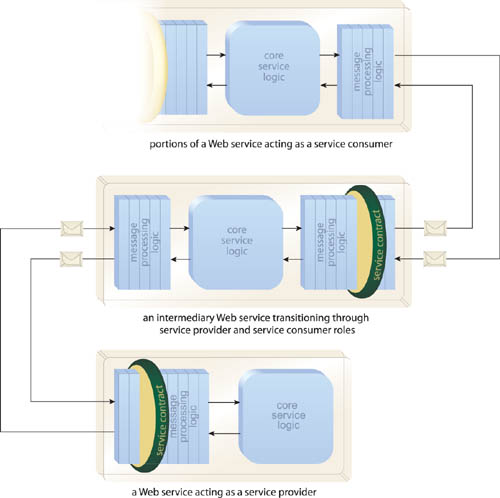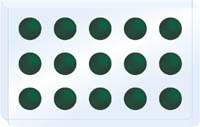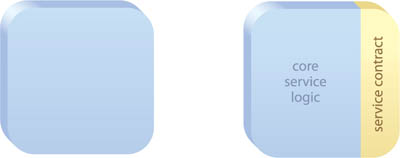
3.2 Service-Oriented Computing Fundamentals
3.3 Service Implementation Mediums
It’s been well established that service-oriented computing represents an ambitious platform with the potential to transform the complexion of an enterprise. Design patterns in support of this platform therefore tackle a spectrum of design problems, ranging from the encapsulation of granular functionality to the strategic partitioning of the enterprise into service-enabled domains.
A constant among all the patterns documented in this book is that each, in some shape or form, impacts or relates to technology architecture. A service, a solution comprised of services, a collection of related services—each has a pre-determined architectural design, each claims its own distinct part of the overarching enterprise architecture, and all are collectively designed to work in concert to realize common strategic goals.
This chapter establishes the fundamental links between service-oriented computing, service-orientation, and technology architecture. You will find this content useful if you are new to SOA or if you need to look up definitions to some of the terms used throughout this book. Also, the upcoming architecture-related definitions provide background information for the service-oriented architecture types explained in Chapter 4. Those types are then subsequently referenced in pattern descriptions.
To prepare for the upcoming discussion of service-orientation and technology architecture in Chapter 4, let’s begin by establishing some fundamental terminology. The next sections establish the following basic architecture-related IT terms:
• Technology Architecture– The fundamental physical design of something.
• Technology Infrastructure– The underlying, supporting technology environment, including software and hardware.
• Software Program– A standalone system that may be a custom-developed application or a purchased product.
We are by no means attempting to formally define these terms for the IT industry. These definitions are simply part of the common vocabulary used by the books in this series to ensure consistency and clarity across all titles. Figure 3.1 further illustrates their meaning.
It’s well-known how the IT community borrowed the term “architecture” from its traditional association with the design and construction of buildings and structures. Its origin also helps us establish an analogy that is useful for distinguishing a technology architecture from a technology infrastructure.
A building has a physical design expressed in an architecture blueprint or specification. However, the building exists within a surrounding environment. This environment may or may not provide a lot of support for the building to fulfill its purpose. For example, an office or residential building located within a city is supported by the streets, power plants, utility pole cables, sewer systems, and other resources provided by the city environment. This supporting environment is analogous to technology infrastructure.
In order for a building to take advantage of these infrastructure extensions, its physical design needs to integrate them as part of its official architecture. Therefore, an architecture specification for a building will encompass the parts of its surrounding infrastructure that are relevant to the building. As a result, there is no firm boundary between what constitutes the building architecture and the environmental infrastructure. This same overlap exists in the IT world, as explained in the following definitions.
A technology architecture expresses fundamental and foundational aspects of physical design for some piece of technology. Whereas computer hardware products will have their own individual technology architectures, within a typical IT enterprise, we are most concerned with the architecture of software programs.
For a program we purchase, we may want to understand its internal design to ensure that it is compatible with the environment already established within our enterprise. For programs we build, it becomes our responsibility to define the physical design ourselves.
When designing a new software program, we need to take into consideration the environment in which it will need to be deployed and in which it will need to carry out its purpose. In most established enterprises, implementation environments already exist in the form of servers, operating systems, and runtime and middleware platforms. As explained in the next section, all of these parts are considered technology infrastructure. And, as with buildings and cities, the software program’s architecture is comprised of new parts interwoven with the relevant parts of the infrastructure that already exist as part of the surrounding environment.
The scope of technology architecture can vary depending on what it is we are designing. Some well-known types include:
• Component Architecture– In a distributed computing environment, this represents the physical structure of an individual software program that exists as a component.
• Application Architecture– A technology architecture with a physical boundary limited to the deployment environment of a particular application or system. In a distributed computing environment, an application architecture can encompass multiple component architectures.
• Integration Architecture– The technology architecture of two or more connected applications or systems including whatever technologies, resources, or extensions were added to enable their integration. Many integration architectures include middleware platforms and associated adapter or bridging extensions.
• Enterprise Technology Architecture– Unlike component, application, and integration architectures, which are often documented in design specifications prior to the creation of programs, enterprise technology architectures frequently result as a documentation of what already exists within an enterprise environment. An enterprise technology architecture specification can encompass (or may just reference) all previously listed forms of architecture and may also act as a formal documentation of the enterprise infrastructure as well.
As shown in Figure 3.2, each of these architecture types represents a different scope, whereby one tends to encompass the other.
In a service-oriented environment the scope of technology architecture can also vary. The distinct forms of service-oriented architectures and how they roughly correspond to the previously listed traditional architecture types is explained separately in the section The Four Types of Service-Oriented Technology Architecture in Chapter 4.
Note
As just mentioned, you can define an architecture for a piece of hardware or a software program, which is why you will sometimes see the term “architecture” further qualified as hardware architecture or software architecture. Because our focus in SOA projects is primarily on software design, why then do we continue using the broader “technology architecture” term? As revealed by many patterns in this book, architecture in the world of service-oriented computing relies on a combination of software and hardware resources, both of which find their way into typical architecture specifications.
Within a typical IT enterprise, technology infrastructure represents the environment in which software programs are deployed. As with the term “architecture,” infrastructure can also be qualified with “software” or “hardware” to identify certain parts of this environment.
Common forms of hardware infrastructure include:
• servers and workstations
• routers, firewalls, and networking equipment
• back-up power supplies, cables, and other computer equipment
Types of software typically considered part of an enterprise’s technology infrastructure include:
• operating systems and system APIs
• runtime environments and system-level service agents
• databases and directories
• transaction management programs and message queues
• middleware and adapters
• user account management and security technologies
What generally distinguishes a technology that is part of infrastructure from one that is exclusive to a particular component or application architecture is that it is made available to multiple applications or systems and therefore exists as a resource of the enterprise (and is therefore also separately owned and governed). An example of a common software program that can be either classified as part of infrastructure or specific to an application architecture is a database (Figure 3.3).
As previously mentioned, relevant pieces of technology infrastructure find their way into almost all forms of architecture documentation because they become part of the architecture itself. An enterprise technology architecture specification often documents some or all of an enterprise’s infrastructure in a reference format that is made available to authors of other architecture design documents.
The infrastructure of an enterprise will frequently determine the processing potential of technology architectures that reside within it and are built upon it. This potential threshold is then further leveraged or constrained by the design of the architecture itself. Consequently, a software program is required to exist and execute within the boundaries and thresholds established by both its underlying infrastructure and architecture (as explained in Figure 3.4).
Figure 3.4 Technology infrastructures and architectures collectively establish boundaries that determine the processing thresholds of software programs. In this example, the maximum instances of a program that can be concurrently invoked is less than what the infrastructure can support because of limitations introduced by the architecture and the software program’s own implementation.

A software program is simply an existing system, application, or solution. It may represent a purchased product or a custom-designed program. In relation to technology architecture, a software program can be considered an implementation of the design documented in an architecture specification, as well as the logic that resides and executes within the supporting environment also specified by the technology architecture.
Part of a software program’s design can be documented within an application architecture specification. Usually this part is backend-centric with an emphasis on the program’s overall structure (including components it may be comprised of), technologies, and resource requirements. A typical application architecture specification is therefore frequently supplemented with additional types of design documents, such as functional specifications that illustrate the flow and style of the program user interfaces and detailed design documents that establish programming routines and algorithms.
Depending on the conventions, methodologies, or preferences of the IT department, this additional design information may or may not be considered part of the program’s official technology architecture (Figure 3.5).
Figure 3.5 The physical design of a software program is partially defined by its application architecture along with relevant parts of the surrounding infrastructure. Other documents, such as a functional specification, establish additional design characteristics, such as the program’s user-interfaces.
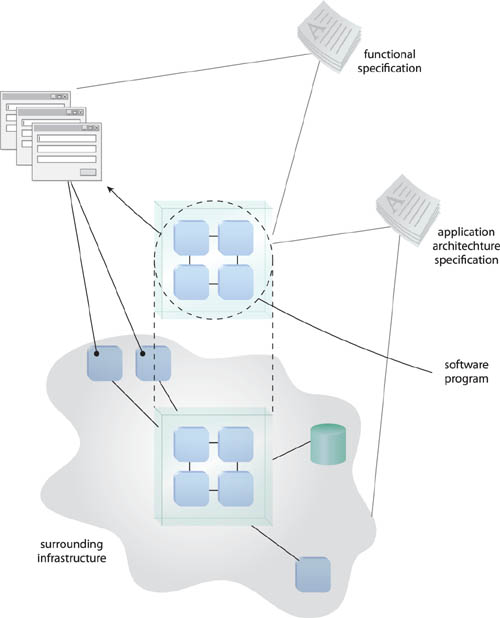
Note
The upcoming Relationship to Design Framework section briefly provides some reference content for readers of SOA Principles of Service Design. If this does not interest you, feel free to skip ahead to the Service-Oriented Computing Fundamentals section.
Chapter 3 of SOA Principles of Service Design documents a base design framework that includes the following terms:
• Design Characteristic– A property of a software program or technology architecture that results from how it was designed. A design characteristic can be any concrete quality, such as the fact that the program is componentized, provides fine or coarse-grained functions, and so on.
• Design Principle– An accepted industry practice with a specific design goal. The service-orientation design paradigm is comprised of a set of design principles that are applied together to achieve the goals of service-oriented computing (as explained in the upcoming Service-Orientation and Technology Architecture section).
• Design Pattern– A proven solution to a common design problem documented in a consistent format. (See the Fundamental Terminology section in Chapter 5 for a full definition of this term.)
• Design Standard– Design conventions customized individually by organizations in order to reliably deliver solutions in support of the organization’s specific business goals. Design standards can support and optimize the application of design principles and design patterns for particular environments and can help ensure the consistent realization of design characteristics. Conversely, design principles and patterns can form the basis of design standards that are then further customized. (Note that design standards should not be confused with industry standards, such as XML and WSDL.)
Figure 3.6 illustrates how closely this design framework can tie into the architecture-related vocabulary we just covered. In the end, principles, patterns, and architecture all revolve around and influence design.
Summary of Key Points
• Technology architecture represents the physical structure and aspects of physical design for a piece of technology. Traditional variations of technology architecture include component, application, integration, and enterprise technology architecture. (These will be compared to service-oriented architecture types in Chapter 4.)
• Technology infrastructure represents the structure and complexion of a technical environment most commonly confined to the boundary of an organization’s enterprise. Technology architectures encompass portions of relevant infrastructure.
• Technology architectures encompass portions of relevant infrastructure.
• A software program is a system or application that is partially defined by and also resides within a technology architecture.
The upcoming sections provide descriptions of common terms used throughout this book.
Service-oriented computing is an umbrella term that represents a new generation distributed computing platform. As such, it encompasses many things, including its own design paradigm and design principles, design patterns, a distinct architectural model, and related concepts, technologies, and frameworks.
Service-oriented computing builds upon past distributed computing platforms and adds new design layers, governance considerations, and a vast set of preferred implementation technologies, several of which are based on the Web services framework.
In this book we make reference to the strategic goals of service-oriented computing as they relate to the application of service-orientation and the design of service-oriented architecture. These goals are briefly described in the section The Method of Service-Orientation in Chapter 4.
Service-orientation is a design paradigm intended for the creation of solution logic units that are individually shaped so that they can be collectively and repeatedly utilized in support of the realization of the specific strategic goals and benefits associated with SOA and service-oriented computing.
Solution logic designed in accordance with service-orientation can be qualified with “service-oriented,” and units of service-oriented solution logic are referred to as “services.” As a design paradigm for distributed computing, service-orientation can be compared to object-orientation (or object-oriented design). Service-orientation, in fact, has many roots in object-orientation and has also been influenced by other industry developments, as shown in Figure 3.7.
The service-orientation design paradigm is primarily comprised of eight design principles, which are listed in the section The Method of Service-Orientation in Chapter 4. These principles are further summarized in Appendix C and referenced by all subsequent design pattern descriptions so as to highlight potential relationships between the application of a pattern and the application of related design principles.
Service-oriented architecture represents an architectural model that aims to enhance the agility and cost-effectiveness of an enterprise while reducing the burden of IT on the overall organization. It accomplishes this by positioning services as the primary means through which solution logic is represented. SOA supports service-orientation in the realization of the strategic goals associated with service-oriented computing. Historically, the term “service-oriented architecture” (or “SOA”) has been used so broadly by the media and within vendor marketing literature that it has almost become synonymous with service-oriented computing itself.
As a form of technology architecture, an SOA implementation can consist of a combination of technologies, products, APIs, supporting infrastructure extensions, and various other parts. The actual complexion of a deployed service-oriented architecture is unique within each enterprise; however it is typified by the introduction of new technologies and platforms that specifically support the creation, execution, and evolution of service-oriented solutions. As a result, building a technology architecture around the service-oriented architectural model establishes an environment suitable for solution logic that has been designed in compliance with service-orientation design principles.
Chapter 4 establishes distinct types of service-oriented architecture and documents four key characteristics that each variation should possess in order to fully support service-orientation. These architecture types are then further referenced by design pattern descriptions in order to highlight the potential scope or applicability of a given pattern.
A service is a unit of solution logic (Figure 3.8) to which service-orientation has been applied to a meaningful extent. It is the application of service-orientation design principles that distinguishes a unit of logic as a service compared to units of logic that may exist solely as objects or components.
Subsequent to conceptual service modeling, service-oriented design and development stages implement a service as a physically independent software program with specific design characteristics that support the attainment of the strategic goals associated with service-oriented computing.
A service corresponds, in scope, to the service architecture type described in Chapter 4. The design patterns in Part III of this book are further dedicated to or related to the design of services.
Each service is assigned its own distinct functional context and is comprised of a set of functions or capabilities related to this context. Therefore, a service can be considered a container of capabilities associated with a common purpose (based on a common functional context). The individual bullet items within the service symbol from Figure 3.8 are capabilities.
The term service capability has no implication as to how a service is implemented. Therefore, this term can be especially useful during service modeling stages when the physical design of a service has not yet been determined (at which point it is further qualified as a service capability candidate). As explained later in the Service Implementation Mediums section, once it is known whether a service exists as a Web service, a REST service, or a component, terms such as “service method” or “service operation” can be used instead.
When a program invokes and interacts with a service it is labeled as a service consumer. It is very important to understand that this term refers to the temporary runtime role assumed by a program when it is engaging a service in a data exchange.
For example, you can create a desktop application that is capable of exchanging messages with a service. When it is interacting with the service, the desktop application is considered a service consumer.
You can also design a service to invoke and interact with other services (which, in fact, forms the basis of a service composition, as explained in the next section). In this case, the service itself will temporarily act as the service consumer (Figure 3.9).
Many of the examples in the upcoming chapters show consumers as services. Furthermore, due to the unpredictable nature of data flow through service compositions, the directionality between consumers and services is intentionally not standardized in diagrams provided in this book (which is a deviation from the left-to-right convention used with traditional client-server illustrations).
A common alternative term for service consumer is service requester. Also, a term often used to represent the runtime role a service assumes when it is being invoked by a service consumer is service provider. These terms originated with the W3C and are therefore often used when services are built as Web services, as shown in Figure 3.10.
Many of the patterns in this book deal with design issues that are related to the interaction between service and consumer. Be sure to constantly keep in mind that any service can also be a service consumer.
A service composition is an aggregate of services collectively composed to automate a particular task or business process (Figure 3.11). To qualify as a composition, at least two participating services plus a composition initiator need to be present. Otherwise, the service interaction only represents a point-to-point exchange.
Much of the service-orientation design paradigm revolves around preparing services for effective participation in numerous complex compositions—so much so that the Service Composability design principle is dedicated solely to ensuring that services are designed in support of repeatable composition. A service composition in itself also represents one of the four SOA types explained in Chapter 4.
The design of a composition entails various architectural considerations in order to ensure that runtime service activities can be carried out as expected. Part IV of this book provides a set of chapters with patterns focused on composition design and related runtime processing.
Note
There are several additional terms associated with service composition design, including:
• composition controller
• composition controller capability
• composition initiator
• composition member
• composition member capability
• composition sub-controller
• service activity
Definitions for these terms are available at SOAGlossary.com.
A service inventory is an independently standardized and governed collection of complementary services within a boundary that represents an enterprise or a meaningful segment of an enterprise (Figure 3.12). When an organization has multiple service inventories, this term is further qualified as domain service inventory, as explained in the pattern description for Domain Inventory (123).
Service inventories are typically created through top-down delivery processes that result in the definition of service inventory blueprints. The subsequent application of service-orientation design principles and custom design standards throughout a service inventory is of paramount importance so as to establish a high degree of native inter-service interoperability. This supports the repeated creation of effective service compositions in response to new and changing business requirements.
The service inventory architecture is one of four SOA types explained in the following chapter. Part II of this book further provides a collection of fundamental and specialized patterns dedicated to service inventory design.
Service-oriented analysis represents one of the early stages in an SOA initiative and the first phase in the service delivery cycle. It is a process that often begins with preparatory information gathering steps that are completed in support of a service modeling sub-process that results in the creation of conceptual service candidates, service capability candidates, and service composition candidates.
The service-oriented analysis process is commonly carried out iteratively, once for each business process. When applied as part of a top-down approach, the scope of a planned service inventory will generally determine the extent of the service-oriented analysis effort. All iterations of a service-oriented analysis then pertain to that scope, with the goal of producing a service inventory blueprint. (Visit SOAMethodology.com for an explanation of the iterative service-oriented analysis process.)
A key success factor of service-oriented analysis is the hands-on collaboration of both business analysts and technology architects. The former group is especially involved in the definition of service candidates with a business-centric functional context because they understand the business processes used as input for the analysis and because service-orientation aims to align business and IT more closely.
The service definition process that is commonly carried out as part of a service-oriented analysis will usually contain steps that correspond to the foundational service patterns provided in Chapter 11.
When conceptualizing services during the service modeling part of the service-oriented analysis phase, services are defined on a preliminary basis and still subject to change and refinement before they are handed over to the service-oriented design project stage responsible for producing the physical service architecture. The term service candidate is used to help distinguish a conceptualized service from an actual implemented service.
It is important to view and position SOA as an architectural model that is neutral to any one technology platform. By doing so, an enterprise is given the freedom to continually pursue the strategic goals associated with SOA and service-orientation by leveraging on-going technology advancements.
Currently, a service can be built and implemented as a:
• component
• Web service
• REST service
Essentially, any implementation technology that can be used to create a distributed system may be suitable for service-orientation.
Many of the design patterns in this book are not specific to any one of these three implementation mediums, but some are. For example, several examples in this book are based on the use of Web services because this service implementation medium has been historically the most popular.
The remaining sections in this chapter briefly introduce each of these implementation options. However, because this book is dedicated to design patterns, complete descriptions of these technologies are intentionally deferred to other series titles.
A component is a software program designed to be part of a distributed system. It provides a technical interface comparable to a traditional application programming interface (API) through which it exposes public capabilities as methods, thereby allowing it to be explicitly invoked by other programs (Figure 3.13).
Components typically rely on platform-specific development and runtime technologies. For example, components can be built using Java or .NET tools and are then deployed in a runtime environment capable of supporting the corresponding component communications technology requirements, as implemented by the chosen development platform.
A Web service is a body of solution logic that provides a physically decoupled technical contract consisting of a WSDL definition and one or more XML Schema definitions and also possible WS-Policy expressions. The Web service contract exposes public capabilities as operations, establishing a technical interface but without any ties to a proprietary communications framework (Figure 3.14).
Figure 3.14 The typical Web service architecture containing a service contract, a component, and message processing logic comprised of event-driven agents, as per the pattern Service Agent (543).

Service-orientation can be applied to the design of Web services. The fact that Web services provide an architectural model whereby the service contract is physically decoupled and vendor-neutral is conducive to several of the design goals associated with service-orientation.
Representational State Transfer (REST) provides a means of constructing distributed systems based on the notion of resources. REST services (or RESTful Services) are lightweight programs that are designed with an emphasis on simplicity, scalability, and usability. REST services can be further shaped by the application of service-orientation principles.
As previously explained in the Web Service and REST Service Design Patterns section in Chapter 1, several REST-inspired candidate design patterns have been developed for this pattern catalog and are published at SOAPatterns.org.
Note
How REST services can be built in support of SOA and service-orientation is explored in the upcoming series titles SOA with REST, SOA with Java, and SOA with .NET.
